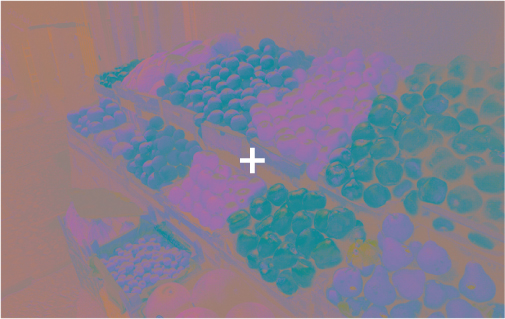
Based on parts of Figure 3.11.37 from Stockman, A., & Brainard, D. H. (2009). Color vision mechanisms. In M. Bass, C. DeCusatis, J. Enoch, V. Lakshminarayanan, G. Li, C. Macdonald, V. Mahajan & E. van Stryland (Eds.), The Optical Society of America Handbook of Optics, 3rd edition, Volume III: Vision and Vision Optics. New York: McGraw Hill.
Form-dependent after-images. In general, chromatic information, although important for object discrimination and identification, is secondary to the perception of form. Colour fills-in the picture delineated by the luminance information. This can be seen in the above demonstration. Fixate the cross in the center of the top chromatic image for several seconds. This image is made up of the complementaries of the chromatic components of the image. Maintain your fixation as you move the mouse over the image.You should then see a correctly coloured version of the picture, the colour of which will gradually fade. The mouse movement causes the chromatic image to be replaced with a luminance image. Notice that if you shift your gaze slightly after the iamges change, so that the after-image no longer aligns precisely with the luminance image, the colour disappears.
You can also try adapting to the middle chromatic image and repeating the demosnstration. The perceived colours in the luminance image are now the complemetaries of those in the original image.
The lower image is of the original scene.
A version of this after-effect demonstration was first described in 1962 by Nigel Daw. Other examples of this illusion along with instructions about how to produce comparable images can be found at: http://www.johnsadowski.com/color_illusion_tutorial.html.
Daw, N. W. (1962). Why after-images are not seen in normal circumstances. Nature, 196, 1143-1145.